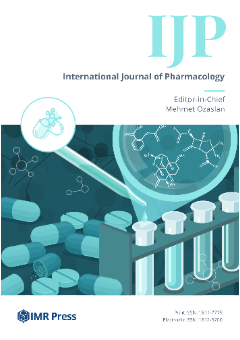International Journal of Pharmacology (IJP) is published by IMR Press from Volume 21 Issue 4 (2025). Previous articles were published by another publisher under the CC-BY licence, and they are hosted by IMR Press on imrpress.com as a courtesy and upon agreement.
Protective Effect of Naringenin Against Isoniazid-induced Adverse Reactions in Rats
Background and Objective: Isoniazid (INH) has a vital role in the treatment of tuberculosis. Nevertheless, the INH-induced hepatotoxicity was documented. Naringenin (NGN) is a dietary flavonoid that has antioxidative and anti-inflammatory properties. The current study aimed to evaluate the protective role of NGN against INH-induced toxicity in male Wister rats. Materials and Methods: One hundred rats were randomly assigned to four equal groups, the control, INH-treated, (INH+NGN)-treated and NGN-treated. Certain hematological parameters, hepatic function markers, lipid and protein profiles in serum as well as the lipid peroxidation and endogenous antioxidants content in the liver were analyzed. The INH and NGN were orally administered at dose levels of 54 and 50 mg kg–1 b.wt., respectively. Statistical analysis was carried out using two-way ANOVA, least significant differences (LSD), Duncan's test and correlation analysis. Results: The INH-treated rats showed a significant decline in the studied hematological parameters, the serum levels of high-density lipoprotein (HDL), albumin (A) as well as the hepatic levels of glutathione (GSH) and activities of catalase (CAT), superoxide dismutase (SOD) and glutathione reductase (GR). This was accompanied by a significant elevation in the levels of total lipids (TL), triglycerides (TG), total cholesterol (TC), low-density lipoproteins (LDL), globulin (G), total bilirubin (TBil) and the activities of alanine and aspartate aminotransferase (ALAT and ASAT) and alkaline phosphatase (ALP) as well as the hepatic levels of malondialdehyde (MDA). In contrast, the administration of NGN 1h prior to INH notably improved all the studied parameters. The rats administered NGN alone showed insignificant differences in all the studied parameters with the controls except for marked reductions in the levels of TL, TC and LDL. Conclusion: This study disclosed that INH administration to Wistar rats, at a high therapeutic dose level, could induce a hepatic injury in addition to certain hematologic and metabolic alterations. Yet, the pretreatment with NGN could ameliorate these alterations via its antioxidative effect.

